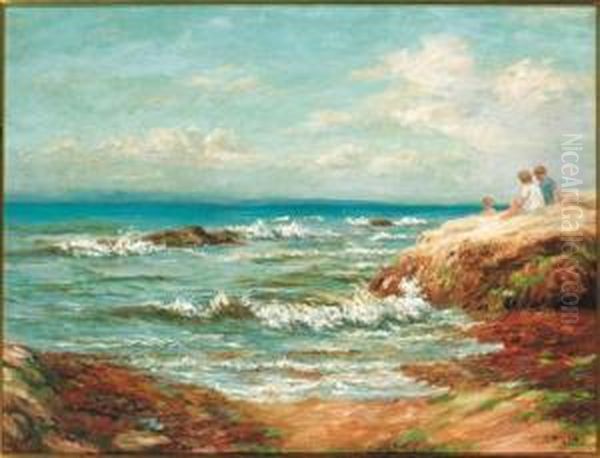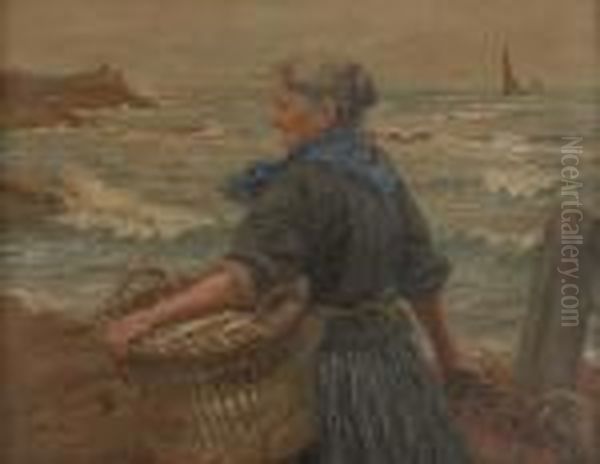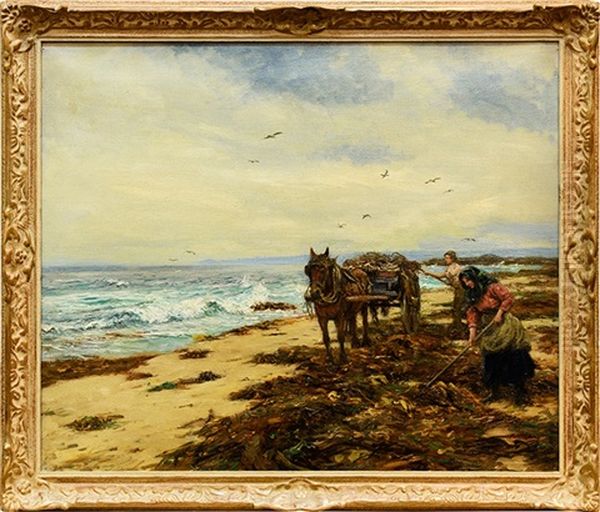Introduction: A Scottish Vision
John McGhie stands as a notable figure in the landscape of Scottish art during the late nineteenth and early twentieth centuries. Born in 1867 and living a long life until 1952, McGhie dedicated his career to capturing the essence of his homeland, particularly its coastal communities and rugged landscapes. His work, encompassing landscapes, genre scenes, and portraits, reflects a fascinating blend of traditional British academic training and the innovative influences emerging from France, particularly Impressionism and Realism. He developed a distinctive style known for its atmospheric sensitivity and honest depiction of Scottish life.
Early Life and Formative Education in Scotland
John McGhie's journey began in Lesmahagow, a parish near Lanark in Scotland, where he was born in 1867. His background was modest; his father worked as a grocer, a detail that perhaps grounded his later interest in depicting the lives of ordinary working people. His formal artistic education commenced at the prestigious Glasgow School of Art. Although his initial period of study there lasted only a year, it provided a foundational experience in the vibrant artistic environment of Glasgow, a city burgeoning with creative energy at the time.
Academic Rigour in London: The Royal Academy Schools
Recognizing his potential, McGhie secured a scholarship that enabled him to further his studies in London. He enrolled at the Royal Academy Schools, one of Britain's foremost art institutions. This period was crucial for honing his technical skills in drawing and painting according to the established academic traditions. Significantly, he had the opportunity to learn from prominent figures of the British art establishment. Among his tutors was the celebrated painter Sir John Everett Millais, a founding member of the Pre-Raphaelite Brotherhood, known for his meticulous detail and narrative power. This training instilled in McGhie a strong sense of structure and draughtsmanship.
Parisian Horizons: Embracing Modernity

Seeking broader artistic horizons, McGhie travelled to Paris, the undisputed centre of the art world in the late nineteenth century. He continued his formal education at the renowned École des Beaux-Arts, further refining his technique. However, perhaps more impactful was his immersion in the Parisian art scene outside the academy walls. He encountered firsthand the revolutionary works of the Impressionists and their followers, artists who prioritized capturing fleeting moments, the effects of light, and scenes of modern life with a newfound freedom of brushwork and colour.
The Influence of French Realism and Impressionism
During his time in France, McGhie absorbed various influences. He studied the works of the French Impressionists, likely observing the techniques of masters like Claude Monet and Camille Pissarro, who excelled in landscape painting and capturing atmospheric conditions. The depiction of contemporary life, central to artists like Edgar Degas, also resonated. Furthermore, McGhie was profoundly influenced by the French Social Realist painters, particularly Léon-Augustin Lhermitte. Lhermitte was known for his dignified and empathetic portrayals of rural peasant life, rendered with technical skill and sensitivity. This exposure to French Realism reinforced McGhie's interest in depicting working communities with authenticity.
Synthesizing Styles: A Unique Artistic Voice
Upon returning to Scotland around 1904, John McGhie began to synthesize the diverse strands of his artistic education and experiences. He did not simply replicate the styles he had encountered but forged a personal approach. His work retained the solid grounding in drawing and composition acquired in London under figures like Millais, but it was now infused with the looser brushwork, heightened sensitivity to light, and atmospheric concerns gleaned from his time in France. This fusion allowed him to create paintings that were both structurally sound and visually evocative, capturing the specific character of the Scottish environment and its people.
Pittenweem: A Muse on the Firth of Forth
A significant portion of McGhie's mature work is associated with the fishing village of Pittenweem, located on the coast of the Firth of Forth in Fife. He was deeply drawn to this location, repeatedly painting its harbour, boats, cottages, and, most importantly, its inhabitants. The fisherfolk of Pittenweem became central subjects in his art. He depicted their daily toil, their resilience, and their intimate connection to the sea with empathy and respect. His paintings of Pittenweem are not merely topographical records but atmospheric studies capturing the interplay of light, weather, and human activity in a specific coastal setting.
Themes of Labour and Landscape

McGhie's fascination with Pittenweem extended to a broader interest in themes of labour, community, and the relationship between people and their environment. His genre scenes often focused on the lives of fishermen, women mending nets, or figures gathered by the shore. These works avoid romanticization, instead presenting a realistic yet sensitive portrayal of coastal life. Beyond the figurative work, McGhie was also an accomplished landscape painter, capturing the distinctive light and rugged beauty of the Scottish coast and countryside. His landscapes often possess a strong sense of place and atmosphere, reflecting his deep connection to his native land.
Portraiture and Notable Works
Alongside his landscapes and genre scenes, John McGhie was also active as a portrait painter. His academic training provided him with the necessary skills to capture a sitter's likeness effectively. One of his known representative works in this genre is the portrait titled Principal George Stewart. This painting is held in the collection of the Paisley Museum and Art Galleries, indicating its public recognition. While perhaps less numerous than his coastal scenes, his portraits likely shared the same qualities of solid draughtsmanship combined with an attention to character and perhaps a subtle atmospheric treatment consistent with his overall style. Another frequently cited work, The Woman and the Sea, exemplifies his focus on the fisherfolk and their environment, blending figurative painting with landscape elements.
Recognition and Exhibition History
John McGhie achieved a degree of professional recognition during his lifetime. His work was exhibited in prominent venues, demonstrating his engagement with the contemporary art world. He showed his paintings in Glasgow, the city where his artistic journey began, and also in London, the heart of the British art market. Notably, he participated in the prestigious Royal Academy exhibition in London in 1911. Consistent exhibition activity in these major centres suggests that his work was seen and appreciated by critics and the public, establishing his reputation as a significant Scottish painter of his generation.
McGhie in the Context of Scottish Art: The Glasgow Boys and Beyond
To fully appreciate John McGhie's contribution, it is helpful to place him within the context of contemporary Scottish art. His career overlapped significantly with the flourishing of the "Glasgow Boys," a group of radical young painters active from the 1880s onwards. Artists like Sir James Guthrie, Sir John Lavery, George Henry, and E. A. Hornel challenged the conservative Edinburgh establishment, embracing influences from French Realism (particularly Jules Bastien-Lepage) and Impressionism, and often focusing on modern rural life with a bolder, more direct style.

While McGhie shared some common ground with the Glasgow Boys – particularly the influence of French painting and an interest in Scottish themes – his style often retained a more traditional, perhaps more solidly modelled feel compared to the sometimes flatter, more decorative, or more overtly Impressionistic approaches of some Glasgow School members. He can be seen as navigating a path between the academic tradition represented by his training under Millais and the modernism championed by his Glasgow contemporaries. He also worked in the shadow of earlier Scottish masters like William McTaggart, often considered a precursor to Scottish Impressionism for his dynamic and light-filled seascapes, whose work McGhie would certainly have known.
Wider Artistic Context: Britain and Europe
Beyond Scotland, McGhie's work relates to broader trends in British and European art. His training under Sir John Everett Millais connects him to the legacy of Pre-Raphaelitism and the mainstream Victorian academic tradition. His time in London meant he was contemporary with internationally renowned portraitists like John Singer Sargent, whose bravura style dominated the society portrait market, offering a contrast to McGhie's likely more restrained approach. His landscape work can be seen alongside that of other British artists exhibiting at the Royal Academy, such as Alfred East, who also engaged with contemporary trends in landscape painting.
His connection to French art, particularly the Realism of Léon-Augustin Lhermitte and the atmospheric concerns of Impressionism (Monet, Pissarro, Degas), firmly places his artistic development within a European dialogue. McGhie represents a generation of British artists who travelled, studied abroad, and selectively incorporated continental innovations into their work, enriching the national school without entirely abandoning their native traditions.
Later Life and Enduring Legacy
John McGhie continued to paint throughout his long life, remaining dedicated to his chosen themes. He passed away in 1952 at the venerable age of 85. His legacy rests on his substantial body of work that captures a specific era of Scottish life, particularly the coastal communities of Fife. He stands as a skilled and sensitive interpreter of the Scottish scene, adept at rendering both the physical environment and the human element within it.
His unique artistic signature lies in his successful synthesis of the rigorous draughtsmanship of his British academic training with the liberated brushwork and heightened sensitivity to light and atmosphere inspired by French Impressionism and Realism. While perhaps not as revolutionary as some of his contemporaries, John McGhie produced work of consistent quality and enduring appeal, offering a valuable window onto the landscapes and people of Scotland at the turn of the twentieth century. He remains a respected figure within the narrative of Scottish painting.
Conclusion: A Painter of Place and People
In conclusion, John McGhie was a dedicated and talented Scottish painter whose career spanned a period of significant artistic change. Educated in Glasgow, London, and Paris, he absorbed diverse influences, from the academic precision of Millais to the modern sensibilities of Lhermitte and the Impressionists. He forged these influences into a personal style well-suited to his favoured subjects: the landscapes, seascapes, and fisherfolk communities of Scotland, especially Pittenweem. Through his numerous paintings, McGhie provided an authentic and atmospheric record of Scottish life, securing his place as a significant contributor to the rich tradition of Scottish art. His work continues to be appreciated for its technical skill, its evocative power, and its honest portrayal of place and people.